One-Day Trip Along the Central Axis of Beijing
Project Pengyou 2016 summer interns Ellen, Yixuan, David, and Xin take a day trip along the Forbidden City’s central axis to explore all that old Beijing has to offer.

The 中轴线 Zhongzhou Xian (Central Axis) refers to a stretch of road in Beijing, China that dissects the city from the 4th ring road in the North to the Temple of Heaven in the South. Many of the landmarks: the Bell Tower, Drum Tower, Jingshan Park and even the Forbidden City, were built during the Yuan Dynasty when royalty still lived opulently in palaces and towers. Because it was considered good fengshui to design the city structure in a symmetrical manner, the resulting “Central Axis” is the longest in the world, and a prime stretch of road to peek into the heart of old Beijing.
If you have one day in Beijing, consider taking a (rather long) stroll down this path! We went for a walk along the central axis to see all the historical architecture that Beijing had to offer:
1. 烟袋斜街 Yandai Xiejie (Yandai Byway)
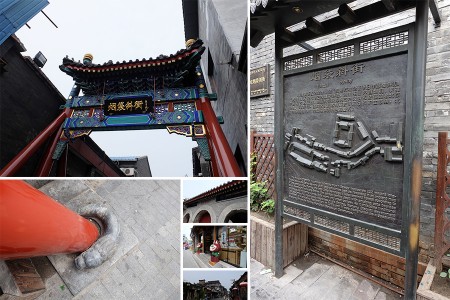
Measuring 232 meters long, the Yandai (literally meaning “tobacco pipe”) Byway was known as Gulou Byway over 2 centuries ago, as recorded in an ancient map of the capital city. During the late Qing Dynasty, it was renamed Yandai, according to local records, and vendors along the street sold smoking sets, paintings, calligraphic works, jade ware and other handcrafts. The Xicheng District government launched a protective restoration of the street in 2007 as it embodies traditional folk customs and distinctive features of old Beijing. It was designated as a “Specialty Shopping Street” by the Beijing Municipal Bureau of Commerce. You can find many restaurants, vendors, specialty stores, and other interesting places like museums and art galleries along the street.
Xin: There were many interesting shops on the Yandai Byway that I wanted to check out in the future! I also found an alcohol museum that had windows and doors shaped like ancient Chinese alcohol containers on our way, but it was closed at that time so we did not get a chance to go in.
Ellen: So there’s probably no trace of its tobacco heritage left in Yandai Byway, besides the name and maybe a vape store.
Yixuan: The shops here are very interesting and was less crowded than other similar streets like Nanluoguxiang.
David: The byway leads to Houhai, the lake, which is bordered by tons of restaurants and bars with bright neon lights, and all the tiny stores really come alive when it’s dark!
2. 荷花市场 Hehua Shichang (Lotus Market)
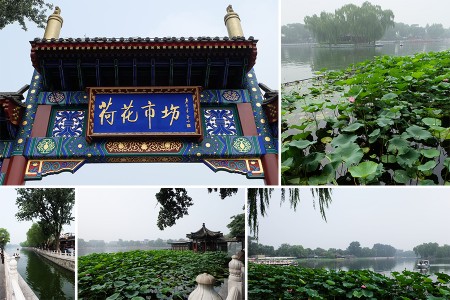
The Lotus Market is at the west side of 前海/Qian Hai (the Front Sea Lake). Developed around the end of the Qing Dynasty, the Lotus Market used to be a seasonal market that opened on May 5th (Dragonboat festival or 端午节). During the summer, it was a really popular market where people of all social statuses came together to hang out by the lakes, enjoy the beautiful lotus flowers, and buy food and groceries in the market. Over the years, it deteriorated and even disappeared for a few decades after the founding of PRC, but in the 1980s it was restored as a tourist attraction with many restaurants, bars, and antique shops.
Xin: There were not as many lotus flowers as I had imagined (but then my hometown was really close to the “village of Chinese lotus flower” which I had visited quite a few times). But it was nice to see some nature in the middle of Beijing. There are tables owned by different restaurants by the lake, and I think it would be nice to eat there when the weather is pleasant.
Ellen: So I was actually expecting a market that specialized in lotus products, but it’s more of a pleasant pedestrian area with some interesting looking restaurants (a North Korean one caught my eye) and a nice view. You can rent out some paddle boats, but I think we all just wanted some AC…
Yixuan: The lotus market mainly has small 小吃 stalls and restaurants, and we saw quite a few people eating an interesting-looking “flowerpot” cake which resembled soil on the top and had ice cream below.
David: The view is really great, but would be more enjoyable on a less hot and humid day. I have never seen such an abundance of lotuses.
3. 护国寺小吃 Huguosi Xiaochi (Huguo Temple Snack Bar)
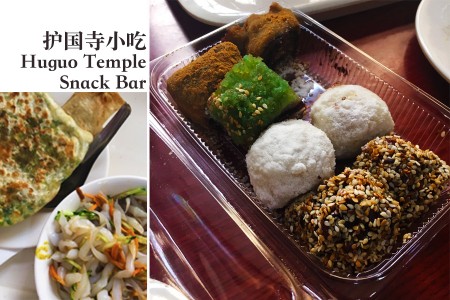
The Huguo Temple Snack Bar is named after the Huguo Temple that was located in Xicheng District. During the Qing Dynasty, the temple would hold a temple fair on the eighth day of every lunar month serving various kinds of snacks. The Huguo Temple Snack Bar was founded in 1956 serving these traditional snacks and since then it has developed into a large chain with nine branches. Some of its specialties include seasoned millet porridge (面茶), fermented soy milk (豆汁) and other sweets such as rolling donkey (驴打滚), glutinous rice roll with red bean covered with soy bean powder and pea cake (豌豆黄).
Ellen: Really busy atmosphere, shaky AC quality, and sort of overwhelming with the sheer number of things available – but a great low cost way to try out some Old Beijing-style treats! Personally loved sticky rice coated in toasted sesame (pictured above).
Xin: I was a little worried at first because the place was super crowded and did not have good lighting so the food did not look that appetizing. But it turned out to be pretty nice. We all tried different kinds of food, and my personal favorites were the spring pancakes and the sweet osmanthus flower jelly cakes, although David thought they tasted like shampoo…
Yixuan: This is a very exciting place for a foodie like me, with rows and arrays of different pastries, rice cakes, and bings, etc that I had never seen before. We saw a lot of people eating this thing that looked like mashed potatoes but was actually the seasoned millet porridge (yellow in colour) covered with sesame sauce (dark brown). Though we tried a wide variety, the food was not really to my taste and our best pick was the humble bing filled with fresh vegetables.
David: This restaurant’s ordering style reminded me of many small, family-run restaurants back in Philadelphia with gruff cashiers taking orders with a brusque efficiency. I ordered a bowl of North Korean cold noodles, which was refreshing on such a warm day.
4. 景山公园 Jingshan Gongyuan (Jingshan Park)
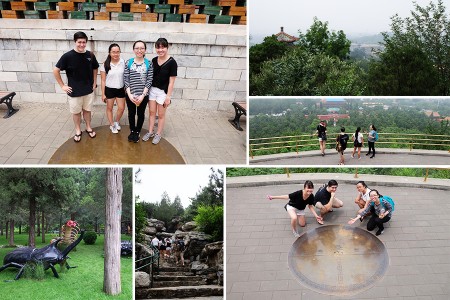
Jingshan Park is a 57-acre park situated north of the Forbidden City, that used to be the palace’s imperial garden. Its namesake, Jingshan (or Scenic Hill), actually refers to the artificial hill in the middle which gives a bird-eye view of central Beijing, including the Forbidden City, the Bell and Drum Towers in the north, and Beihai Park and White Dagoba Temple in the west. The central point of the N-S axis of Beijing is located on the peak of the hill, a 20-minute climb that is totally worth it. When we were there, there was an insect exhibition going on with life-size figures.
Ellen: I loved the massive statues of insects in their temporary exhibit. Sadly it was all look and don’t touch, so we missed out on some great photo opportunities.
Xin: Interesting fact about Jingshan — this mountain is actually man-made using all the rocks and soil from the construction of palaces in the Sui Dynasty (581-618 A.D.).
Yixuan: The climb would have been more enjoyable in better weather and we were drenched in sweat by the time we reached the peak. The view was great, though!
David: Jingshan was blazing in the afternoon sun, but it was great to finally visit the peak that caught my eye at the exit of the Palace Museum.
5. 故宫博物馆外围 Gugong Bowuguan Waiwei (Outside the Palace Museum)
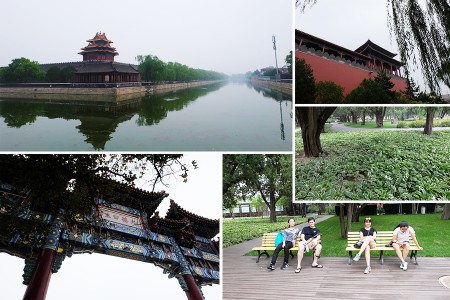
Gugong is the Palace Museum in the Forbidden City. It is immediately surrounded by a rectangular lake and large crowds of visitors to the Palace Museum. In order to enter the outer courtyards of the Palace, you have to enter through Tiananmen gate and go north. To exit the courtyard outside the Palace Museum, visitors must exit from the Eastern Gate. It lets out in the corner of the lake, so you must exit by traveling along the lake or by entering a scenic park to the southeast of Gugong.
Ellen: Gugong is massive! Walking along the wall southward, we actually realized that the surrounding area of the wall was pretty quiet and residential. Once you hit the entrance to the museum though, there are swarms of people all trudging from south to north (the newly mandated touring direction). Also watch out for those golf carts, full of tourists too tired to walk!
Xin: There were so many people everywhere! It was nice to see the outside of Gugong, though, because most people would not pay attention to the moat and the corner towers, which were actually quite beautiful.
Yixuan: We did a lot of people-watching as we walked – a lot of families with kids. It was quite a long walk, and we were thankful for the rest in the park (even with the 2-yuan entrance fee) as it allowed us to escape the crowds for a bit.
David: I had come here once before, but I took a really long route around the park because I didn’t want to pay 2 yuan. I should have paid the 2 yuan. The park is really nice and deserves its own visit on a trip to the Forbidden City.
6. 天安门广场 Tian’anmen Guangchang (Tian’anmen Square)
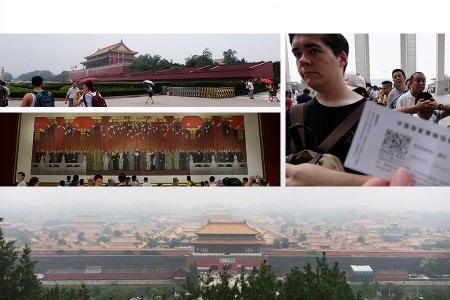
Tian’anmen is the gate from which Mao announced the creation of the People’s Republic of China. The square to the south of it houses several important national landmarks such as the Monument to the People’s Heroes, Mao’s Mausoleum (Maosoleum, anyone?), and the National Museum of China. Mao’s Mausoleum is only open in the mornings, so plan ahead for that in a trip down the central axis. Within the large National Museum of China, there are many exhibitions detailing important cultural aspects of China. There is a large room dedicated to Chinese art since 1949, including a very large painting of the leaders of the People’s Republic of China in 1949. There are also exhibits on the silk road, Chinese currency, ancient writing, and Chinese calligraphy.
Ellen: I thought the permanent exhibit about commissioned national paintings was really fascinating, especially the painting of the leaders of the Communist Revolution painted as these young radical intellectuals — so different from my personal notions of the leaders.
Yixuan: The museum was really cool and I wished we had more time there. There was an elaborate queueing process to enter, but it was really vast inside. The painting exhibition was the highlight for me, but I wished I could better understand the descriptions as they were written in complex Chinese.
Xin: All the exhibitions held by the museum were completely free, which provides a really good educational opportunity for the public. I have been here a couple of times before, but I would want to visit it again in the future!
David: Make sure to not wear slippers or flip-flops! I had to run and buy cheap shoes from a nearby shop because I wasn’t allowed in the National Museum with flip-flops.
7. 全聚德烤鸭 Quanjude Kaoya (Quanjude Roast Duck Restaurant)
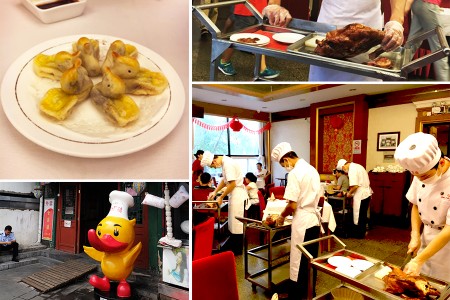
Quanjude was first established in 1864 during the Qing dynasty and catered only to the imperial families. Today, us commoners can get access to this imperial dish through one of Quanjude’s eight Beijing locations. A favorite of Premier Zhou Enlai, Quanjude’s name has become synonymous with Peking duck.
Ellen: It was pretty sad to realize that all four chefs behind me were carving ducks for other tables, but it just made the wait all the more worth it when our roast duck rolled in on its trolley.
Yixuan: The duck was very well executed, with crisp, rich skin. We sat in a banquet-style hall with slightly old-fashioned decorations, as this is one of their earlier stores. It may be a bit pricier than other Peking duck places, but it is worth trying at least once!
Xin: Duck skin with Chinese green onions, fried duck, and little duck-shaped pastries were all really good! Not for the duck soup (water) though, but it was free.
David: It was a really cool restaurant. It seemed very popular for parents who wanted to take their child out to a restaurant. It seemed like we were surrounded by three person families.
8. 前门大街 Qianmen Dajie (Qianmen Street)
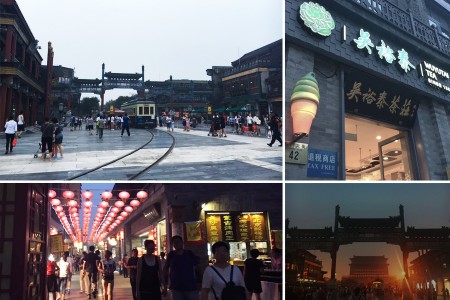
Qianmen, literally “Front Gate”, is a nickname for the southernmost central gate in Beijing’s city wall, Zhengyangmen. Equipped with an arrow tower, the gate was a defensive fortress, and has a pretty intense history — it was built in 1419, burnt down in 1900 during the anti-foreign, anti-Christian Boxer Rebellion, reconstructed in 1914, and taken over by the People’s Liberation Army in 1949. Today, only the gateway door remains, and stands behind a large pedestrian street full of historical Chinese shops and new international brands, all housed in Qing dynasty-style buildings, as well as busy street food stalls in the hutongs that branch off the main street.
Ellen: The main street definitely feels more commercial, with big brands like Zara and a tram that only goes up and down the street, but I really loved the sensory overload of the narrow hutongs on the west side.
Xin: All the restaurants were really crowded, but we already had dinner at Quanjude, so we just walked around drinking tea or eating ice cream from Wuyutai Tea House. Definitely recommend this place to people who are interested in getting traditional Beijing food, but some of them will probably require a sense of adventure!
Yixuan: Explore some of the side streets as they are really interesting and have cool restaurants! They also sell peking duck (pre-wrapped before your eyes).
David: This seems like a great place to shuffle through sampling all the street foods. Come hungry!
Is there a specific location in this trip that you are interested in checking out? Are there more places that you want to visit in the Forbidden City area? Leave a comment and let us know!
Photo credits: Xin Xie and Ellen Hao